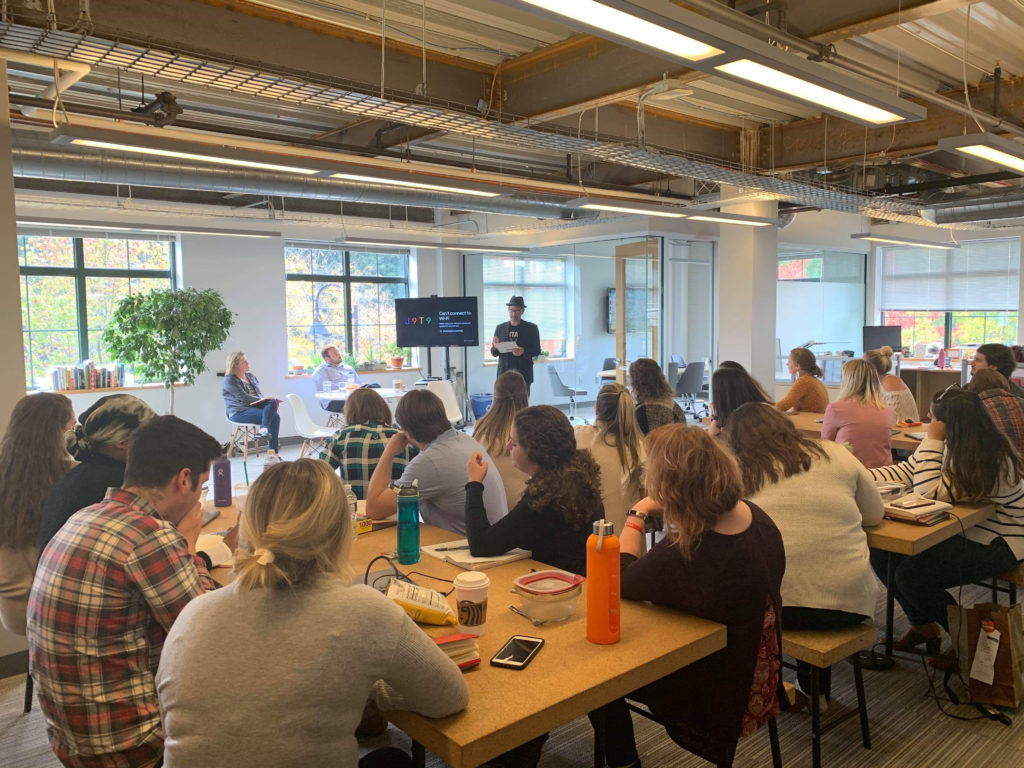Yeah, we got one, too.
Personal Essay Writing
It takes a certain kind of organization to make money and develop its people in equal measure. The national PR agency, InkHouse, recently created Hindsight 2020, a book of essays written by the team about moments of consciousness that opened them up to new points of view. According to CEO, Beth Monaghan, such moments of clarity are important in PR because new connections are the essence of stories that allow someone else’s experience to exist next to our own. That is the very job of PR, to bring people and ideas together.

As the coach and developmental editor for Hindsight, I oriented prospective writers to the judging criteria. This criteria would be used to select the top 20 entries for inclusion in the book—and eventually the top three winners as well. Each essay was scored in four categories, with a maximum amount of 25 points per category: VOICE, STRUCTURE, PROFICIENCY, and IMPACT.
VOICE, or: How well the writer’s unique voice comes through in content and expression.
- Since this was a work setting, the first thing to tackle was how comfortable authors felt to liberate their voice. Wasn’t this work, after all? How close did they want to allow their co-workers to get? I encouraged them, wherever appropriate, to get personal. This was the kind of workplace in which people really did want to get to know each other, and not just use inside information to seize a weakness and climb past someone else on the corporate ladder.
- Trying too hard is an inherent turnoff for audiences in both PR and in essay writing, so I tried to steer writers away from trying to impress. At the same time, it wouldn’t do to go to the opposite pole and try to shock anybody on purpose, to put the chip on the shoulder on full display.
- Rather, they were encouraged to consider who their true audience members were. Was there one person at work who got them? Who can you tell your truth to? Who raises your frequency? Who calls you to account? Who loves you at your best?
- Because see, here’s the thing: There is no such thing as voice in the abstract—there is only tone of voice. Or to put it another way, you don’t look for your voice; you find your audience. And then the tone you take to ring some bells for them, that is what delivers a great sentence. And another one…
STRUCTURE, or: How well the piece evolves around its theme, balances digressions, and creates links and repetitions.
- For readers of this blog, it will come as no surprise that I recommend honing in on one’s theme as the key to structure. The overarching theme of Hindsight was a moment of clarity that opened the author up to another point of view, a new perspective, or a new curiosity. It could be a historical event, a moment in their life, or their work. Writers then chose a personalized embodiment of that theme.
- When presented with such a topic, you may have more than one possibility floating around your head. If that was the case, I recommended trying out several possibilities—and being honest about which one really had your heart and mind. Where the writing goes, the writer needs to go after it.
- Once a moment of clarity was chosen, it was examined; when examined, it was seen to be actually a series of moments. Scenes, if you will. I ran through the five definitions of scene to help generate first draft material, select second draft material and hone third draft material.
- Finally, we discussed placing those scenes in either chronological or narrative order. We took it as a matter of aesthetic faith that there was a perfect order for one’s chosen scenes that would best relate a moment of clarity that had stayed with its author.
PROFICIENCY: Or, Proper sentence and narrative structure; capable handling of facts and research where necessary.
- Since we were exploring writing within a public relations environment, it was important to place the essay in the wider context of the world. Such “data” could include findings from a study, a quote from an expert, or statistics that would bring in a degree of objectivity.
- We didn’t cover topics like grammar or consistency of stylistic usage, but we did touch on how to use the drafting process to bring out clarity in their work. Earlier drafts sometimes can only ask a question that the later drafts will answer. Working on an essay five times will make it stronger than working on it once. That sort of thing.
IMPACT: Or, Effect on the reader in terms of opens up a new point of view/curiosity.
 I loved this criteria for judging. At the same time, an author will never know that. Or rather, the only way to assess what topic and approach will move others is to assume if it really relates to you, it will relate to us.
I loved this criteria for judging. At the same time, an author will never know that. Or rather, the only way to assess what topic and approach will move others is to assume if it really relates to you, it will relate to us.- The question then becomes: What’s in it for me? Which topic, which aspect of that topic will lead to greater self-knowledge? What are you still trying to understand? If you ask yourself a key question, readers may ask it of themselves.
- To get the answer, of course, you have to open yourself up. You have to allow yourself to be changed. What space do you want to move into? Where is the energy coming from that needs to be liberated? Or to put it another way, in order to make something interesting to other people, you may have to scare the shit out of yourself first.

Leave a Reply